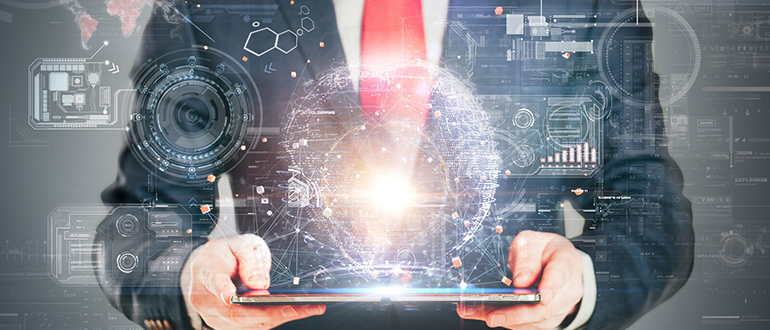AI agents are unlike any technology ever

“Reasoning” and “acting” (often implemented using the ReACT — Reasoning and Acting) framework) are key differences between AI chatbots and AI agents. But what’s really different is the “acting” part. If the main agent LLM decides that it needs more information, some kind of calculation, or something else outside the scope of the LLM itself, it can choose to solve its problem using web searches, database queries, calculations, code execution, APIs, and specialized programs. ... Since the dawn of computing, the users who used software were human beings. With agents, for the first time ever, the software is also a user who uses software. Many of the software tools agents use are regular websites and applications designed for people. They’ll look at your screen, use your mouse to point and click, switch between windows and applications, open a browser on your desktop, and surf the web — in fact, all these abilities exist in Anthropic’s “Computer Use” feature. Other tools that the agent can access are designed exclusively for agent use. Because agents can access software tools, they’re more useful, modular, and adaptable. Instead of training an LLM from scratch, or cobbling together some automation process, you can instead provide the tools the agent needs and just let the LLM figure out how to achieve the task at hand.
Live On the Edge
/dq/media/media_files/2024/11/22/ECd4uE6hGEeyELEJRH39.jpg)
Why live on the edge now? Because, despite public cloud usage being ubiquitous, many deployments are ad hoc and poorly implemented. “The focus of refactoring cloud infrastructure should be on optimizing costs by eliminating redundant, overbuilt or unused cloud infrastructure,” says Gartner. ... Can edge computing also benefit the environment? Yes, according to a study by IBM Corp. “One direct way is by using edge computing to monitor protected species of wildlife inhabiting remote places,” IBM says. “Edge computing can help wildlife officials and park rangers identify and stop poaching activities, sometimes before these offenses even occur.” Another relates to energy management. “Edge computing supports the use of smart grids, which can deliver energy more efficiently and help businesses leave a smaller carbon footprint,” IBM notes. “Grid or distributed computing is where a group of machines and networks work together for a common computing purpose. Resources are utilized in an optimized manner, thus reducing the amount of waste that can occur when large quantities of power are consumed.” More significantly, edge computing can also support the remote monitoring of oil and gas assets.
Getting started with AI agents (part 1): Capturing processes, roles and connections

An organizational chart might be a good place to start, but I would suggest
starting with workflows, as the same people within an organization tend to act
with different processes and people depending on workflows. There are available
tools that use AI to help identify workflows, or you can build your own gen AI
model. I’ve built one as a GPT which takes the description of a domain or a
company name and produces an agent network definition. Because I’m utilizing a
multi-agent framework built in-house at my company, the GPT produces the network
as a Hocon file, but it should be clear from the generated files what the roles
and responsibilities of each agent are and what other agents it is connected to.
Note that we want to make sure that the agent network is a directed acyclic
graph (DAG). This means that no agent can simultaneously become down-chain and
up-chain to any other agent, whether directly or indirectly. This greatly
reduces the chances that queries in the agent network fall into a tailspin. In
the examples outlined here, all agents are LLM-based. If a node in the
multi-agent organization can have zero autonomy, then that agent paired with its
human counterpart, should run everything by the human.
Preparing Project Managers for an AI-Driven Future
Right now, about 95% of AI conversations are around tools that help people do
their jobs better, like ChatGPT or other large language models. For most project
managers, AI can be a huge timesaver. Think of it as a tool that takes on
repetitive tasks—like summarizing meeting notes or helping with scheduling—so
you can focus on higher-value work. ... AI can free you up to focus on the
strategic parts of your job. It’s not here to replace project managers; it’s
here to make them more efficient. At this moment, a lot of people are using AI
from a personal or group productivity perspective. But they are increasingly
going to depend on AI as part of their team. You’re already managing more AI
than you might think. And in the future, you’ll be managing a lot more. Some
things will be done by people and some things will be done by machines and we
need to make sure the whole thing is happening in a totally planned way. ...
First thing to understand is that AI projects are data projects. If you’re used
to traditional software projects, where functionality is front and center, AI is
different. AI relies on data quality—"garbage in, garbage out,” as they say.
Your primary focus needs to be on getting the right data in and managing the
outputs, which are data as well.
Making quantum computing accessible through decentralization

A decentralized model for quantum computing sidesteps many of these challenges.
Rather than relying on centralized hardware-intensive setups, it distributes
computational tasks across a global network of nodes. This approach taps into
existing resources—standard GPUs, laptops, and servers—without needing the
extreme cooling or complex facilities required by traditional quantum hardware.
Instead, this decentralized network forms a collective computational resource
capable of solving real-world problems at scale using quantum techniques. This
decentralized Quantum-as-a-Service approach emulates the behaviors of quantum
systems without strict hardware demands. By decentralizing the computational
load, these networks achieve a comparable level of efficiency and speed to
traditional quantum systems—without the same logistical and financial
constraints. ... Decentralized quantum computing represents a transformative
shift in how we approach advanced problem-solving. By leveraging accessible
infrastructure and distributing tasks across a global network, powerful
computing is brought within reach of many who were previously excluded.
Data Security vs. Cyber Security – Why the Difference Matters

Cybersecurity is the practice of safeguarding digital systems, networks, and
programs from attacks that aim to steal, alter, or destroy sensitive data,
extort money through ransomware, or disrupt business operations. Despite a
substantial $183 billion investment in traditional security measures in 2023 and
projections indicating a 14% increase in these security budgets for 2024, data
breaches surged by 78%, reaching a record high. ... Data is the most valuable
commodity of a company, yet we don’t see resource allocation and time investment
in data security reflecting this importance. Data security involves protecting
the data itself. Once protected, the data can travel anywhere and remain
protected. Having the fine granularity to safeguard the data allows you to grant
users the minimum access necessary for their job functions. When someone does
need to use the data, they must be authorized to do so. ... Zero trust data
protection techniques significantly enhance data security posture and business
value. The first step to improving security and data value is identifying the
most at-risk yet least accessed data. It’s essential to assess the need for
clear-text visibility of high-risk data across people, processes, and systems
and to consider the business impact of minimizing this risk, including factors
like regulatory compliance, reputation, and insurance.
Is Your Phone Spying On You? How to Check and What to Do

“For years, people have noticed advertisements for products they recently
discussed in conversation — even without searching for them online — suddenly
appear on their devices. While many dismissed this as a coincidence or
attributed it to targeted advertising based on online searches, it turns out
there’s more to the story. According to a report by 404 Media, a marketing
firm has confirmed that smartphones are not just tracking users' online
activity — they are also listening to what you say out loud, near your phone.
“Smartphones might indeed be listening to our conversations, thanks to a
technology known as “active listening.” This unsettling discovery comes after
a marketing firm, whose clients include tech giants like Google and Facebook,
admitted to using software that monitors users’ conversations through the
microphones of their devices. This admission has raised serious questions
about privacy, user consent, and the ethics of targeted advertising. … For
better or for worse, there is generally nothing illegal about using audio
information to target advertising. While it is obviously illegal to spy on
someone without their consent, most phone users have given their permission
for this practice without knowing, according to legal experts.
CNCF Brings Jaegar and OpenTelemetry Closer Together to Improve Observability

In the wake of adding support for OpenTelemetry, the project is now working on
revamping the user interface for Jaegar to make that data more easily
discoverable in addition to normalizing dependency views. In addition, the
project is moving toward adding support for the Storage v2 interface to
consume OpenTelemetry data natively along with adding support for ClickHouse
as the official storage backend for tracing data. Finally, the project intends
to add support for Helm Charts and an Operator that will make deploying Jaegar
on Kubernetes clusters simpler. ... The challenge, of course, has been
first finding the funding for observability initiatives, followed then by the
issues that arise as DevOps teams move to consolidate tooling. Many software
engineers naturally become attached to a particular monitoring tool.
Convincing them to swap it out for another platform requires effort and, most
importantly, training. Each organization will individually decide to what
degree they may want to drive tool consolidation, however, in many cases, the
cost of acquiring an observability platform assumes savings will be generated
by eliminating the need for other tools.
Zero Days Top Cybersecurity Agencies' Most-Exploited List

The prevalence of zero-day vulnerabilities on this year's list is a reminder
that attackers regularly seek ways of exploiting widely used types of software
and hardware before vendors identify the underlying flaw and fix it. The joint
security advisory also details guidance prepared by CISA and the National
Institute of Standards and Technology designed to improve organizations' cyber
resilience to better combat all types of cybersecurity threats. Specific
recommendations also include regularly using automated asset discovery to find
all of the hardware, software, systems and services inside an IT
organization's estate and locking them down as much as possible; prepping and
testing incident response plans; and keeping regular, secure backups of copies
which get stored off-network to facilitate rapid repair and restoration of
systems. The guidance also recommends implementing zero trust network
architecture, using phishing-resistant multifactor authentication as an
identity and access management control, enforcing least-privileged access, and
reducing the number of third-party applications and unique types of builds
used.
Achieving Optimal Outcomes in Security Through Platformization

Platformization unifies multiple solutions and services into a single
architecture with a shared data store and streamlined management. With native
integrations, each component becomes more powerful than standalone products.
This approach helps increase productivity, simplify operations, and extract
the most value from data, all leading to better security outcomes and greater
efficiency. ... Using the platform approach should never entail giving up
security efficacy for the sake of vendor consolidation or simplified
management. If there is a corresponding set of point products in a given area,
the minimum bar by which the “platform” component must be measured is the very
best of those individual tools. Flexibility and scalability are important. A
platform needs to empower your company to gradually grow into using it. A
total “rip and replace” of multiple security tools at once is far more complex
than most enterprises are willing to attempt. It’s even harder when you factor
in the differing replacement cycles of existing solutions. You need the option
to adopt the platform piece by piece or all at once – whichever suits your
organization best – while retaining the ability to cover all your security
bases.
Quote for the day:
“Opportunities don’t happen, you
create them.” -- Chris Grosser
No comments:
Post a Comment